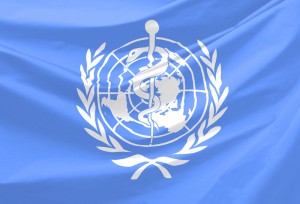
GENEVA. The World Health Organization’s investigation in the Ukraine concluded that the severity of the swine flu outbreak in Ukraine was not (statistically) “excessive” in comparison to other countries. Preliminary genetic sequencing revealed no significant changes in the H1N1 virus; it should respond to vaccines.
LVIV. Initial findings, presented in a NY Times analysis, suggests the swine flu outbreak challenged Ukraine’s fragile health care system; official and personal actions helped to deepen the crisis. “Serious cases mounted because the sick avoided hospitalization until their illness was dangerously advanced, stockpiles of Tamiflu were locked in centralized locations and the supply of ventilators fell short.”
Editor’s Note: Though not explictly stated, the NY Times report seems to suggest that Ukrainian public health officials were slow to realize that an H1N1 outbreak was emerging; this may hint at an underdeveloped virus surveillance network.


NY Times: Fragile Care Worsened Swine Flu in Ukraine
WHO: Pandemic (H1N1) 2009, Ukraine – update 2
WHO: Pandemic (H1N1) 2009 – update 74
Tagged: Care and Treatment, flu, h1n1, influenza, International News, swine flu
- Published:
- November 18, 2009 – 2:20 pm
- Author:
- By The Editor
- Categories:
-
- Comments:
Opinion research conducted by the University of Chicago last year indicated Americans support paid sick leave by large majorities regardless of political persuasion. Most Americans consider paid sick leave a basic workplace right.
“86% of respondents believed that employers should be required by law to provide paid sick days to workers; 85% endorsed a plan that would require a minimum of seven paid sick days per year.”
In the University of Chicago opinion study, 68% of those who were “not eligible for paid sick days said they had gone to work with a contagious illness like the flu”; 17% of respondents indicated “that they have lost a job or were told they would lose their job if they took time off due to personal or family illness.”
A more recent national survey of business conducted by the Harvard School of Public Health found that 74% of businesses offered paid sick leave for employees. However, only 35% of businesses offered paid leave that would allow employees to take care of sick family members; even fewer (21%) allowed paid time off to care for children in the event schools or daycares were closed.
Only 12% of businesses surveyed had made changes to their employee policies since the advent of H1N1 last spring.
Harvard University: Four-Fifths of Businesses Foresee Severe Problems Maintaining Operations If Significant H1N1 Flu Outbreak. Employees Will Face Challenges As Few Businesses Offer Paid Leave to Care for Sick Family Members, Wednesday, September 9, 2009 Press Release
University of Chicago, National Opinion Research Center (NORC): Paid Sick Days – A Basic Labor Standard for the 21st Century -PDF
Tagged: Care and Treatment, flu, h1n1, influenza, swine flu, US News
- Published:
- November 17, 2009 – 12:54 am
- Author:
- By The Editor
- Categories:
-
- Comments:
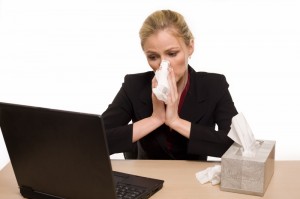
Around 51 million people, comprising a third of the U.S. workforce, do not have paid sick days. Hence, staying home from work is not an option for many Americans in the event H1N1 strikes.
An ailing economy, in conjunction with weak sick leave policies are fueling concerns about the spread of H1N1 virus. In a recent nationwide survey, 84% of workers reported feeling pressured to come to work sick because of the recession. Workers in retail and restaurant sectors say their corporate policies discourage them from calling in sick.
Despite administration appeals for “flexible and nonpunitive” sick leave policies, workers without paid sick leave have been penalized for absences. The “current system”, according to recent congressional testimony from Deputy Secretary of Labor, “forces too many sick workers to go to work and too many working parents to send sick children to school and day care.”
Against this backdrop, Congress has proposed emergency legislation that would provide five or seven days of paid sick leave for companies employing 15 or more persons. Although such measures would be temporary, small business advocates are opposed to any legislative mandate, and consider the proposed congressional measures “expensive and unnecessary.”

AFP: No paid sick leave hampers US swine flu battle
BLS: Employee Benefits in the United States news release text
CNN: Obama administration urges employer flexibility in H1N1 fight
LA Times: For many ill with the flu, staying home isn’t an option
Mansfield Communications: Over 90% of fellow employees do not want you to come to work with any H1N1 flu symptoms, New York – October 20, 2009
NY Times: Lack of Paid Sick Days May Worsen Flu Pandemic
WM: Dodd, DeLauro to Offer Emergency H1N1 Sick Days Bill
WSJ: House Bill Introduced to Require Paid Sick Leave for H1N1 Cases
Tagged: Care and Treatment, flu, h1n1, influenza, swine flu, US News
- Published:
- November 17, 2009 – 12:04 am
- Author:
- By The Editor
- Categories:
-
- Comments:
- Published:
- November 16, 2009 – 2:57 pm
- Author:
- By The Editor
- Categories:
-
- Comments:
In a widely reported story, the Center for Disease Control (CDC) presented revised estimates on H1N1 mortality, including 540 estimated deaths among children to date; 35 such deaths were reported for the week ending 7 November.
| |
H1N1 |
Seasonal |
| Deaths |
3,900 |
36,000 |
| Pediatric deaths |
540 |
80 |
| Hospitalizations |
98,000 |
200,000 |
Source: CDC
This raises questions as to how CDC arrives at these numbers. The task is complicated by the fact that many people with flu don’t seek medical care; few who do are tested. Hospitalizations and deaths are also underreported.
To correct for this, CDC applies a median “multiplier” of 2.7 to reported and extrapolated hospitalizations for influenza like illnesses (ILI) obtained from the Emerging Infections Program (EIP), a surveillance network spanning ten states.
This multiplier is derived from Monte Carlo simulations on a model that adjusts for “underrecognized” factors and health-seeking behaviors. Example: if the percentage of persons seeking medical care increases, multiplier effects would fall.
Deaths are computed using a fraction (around four percent overall) of estimated hospitalizations. However, these percentages also vary across age groups.
CDC: 2009 H1N1-Related Deaths, Hospitalizations and Cases: Details of Extrapolations and Ranges: U.S., Emerging Infections Program (EIP) Data – PDF
CDC: Estimates of 2009 H1N1 Influenza Cases, Hospitalizations and Deaths in the United States, April – October 17, 2009
CDC: Estimates of the Prevalence of Pandemic (H1N1) 2009, United States, April–July 2009 – PDF
USA Today: Swine flu has killed 540 kids, sickened 22 million Americans
Tagged: flu, h1n1, influenza, swine flu, US News
- Published:
- November 15, 2009 – 11:12 pm
- Author:
- By The Editor
- Categories:
-
- Comments:
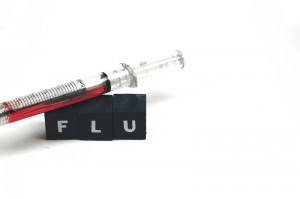
GENEVA: The World Health Organization (WHO) expressed concern that some opinion is dismissing the H1N1 pandemic as a mild situation due to the self-limiting nature of symptoms generally observed in most who contract H1N1. As with seasonal influenza, WHO officials note that H1N1 transmission is highest during the winter season, and most people recover from the virus without medical intervention.
However, WHO officials cited patterns in H1N1 that are strikingly different from seasonal influenza. H1N1 has circulated at high levels during the summer months, which is unusual for influenza, and the majority of serious illness, complications and deaths has occurred in persons under the age of 65. In some countries, the surge in serious H1N1 cases has put pressure on intensive care units.
WHO indicated that there has been no widespread resistance in H1N1 to antiviral medications. Over recent weeks, WHO reports that H1N1 vaccination programs have been administered in 20 countries with no serious side-effects seen. Getting H1N1 flu vaccine to developing countries is a concern; 200 million doses have been pledged from donor countries and companies, none have yet been delivered.


CIDRAP: WHO warns countries not to underestimate pandemic virus
WHO: Press Conference 5 November, 2009 – PDF file
Tagged: Care and Treatment, flu, h1n1, influenza, International News, swine flu, Vaccine Updates
- Published:
- November 10, 2009 – 6:51 am
- Author:
- By The Editor
- Categories:
-
- Comments:

Kaaba in Grand Mosque, Mecca
RIYADH: Saudi Arabia’s Health Ministry announced that
the kingdom will not ban anyone considered at high risk for swine flu from the Hajj pilgrimage, which will peak during the 25-29 November timeframe. The Hajj pilgrimage is required of all able-bodied Muslims at least once in their lifetime, and it attracts an estimated 2-3 million people annually from across the globe. Saudi officials and the WHO have
advised pilgrims to get flu vaccination shots at least two weeks before travel to Mecca and Medina.
The kingdom recently launched a national swine flu vaccination campaign
and has ordered 11 million doses of swine flu vaccine; local Saudi pilgrims, health workers and officials connected with the pilgrimage are top vaccination priorities. In preparation for the religious event, the kingdom has also set up an emergency operations center and special quarantine hospitals, stockpiled antiviral medications, and has situated thermal screening equipment at entry control points.

AFP: Saudis to begin mass flu vaccinations as hajj nears
AP:Saudi says swine flu shots advised for pilgrims
U.S. Department of State Travel Alert: Hajj
Tagged: flu, h1n1, influenza, International News, swine flu
- Published:
- November 10, 2009 – 6:15 am
- Author:
- By The Editor
- Categories:
-
- Comments:

Lviv, Ukraine
The World Health Organization (WHO) sent an nine-person investigation team on Monday (2 Nov), to Kyiv, Ukraine at the request of the government to investigate H1N1 outbreak affecting the western portion of the country.
According to Ukraine’s Ministry of Health, the country has recorded more than 235,000 influenza cases with 235 patients requiring intensive care. The ministry claimed 70 deaths in the country from acute respiratory illness. Although there has been one confirmed death from H1N1 in the country, WHO is assuming most illness is from H1N1 as this the predominant strain of flu.
The outbreak is most acute in the Ternopil, Lviv, Ivano-Frankivsk, and Chernivtsi regions. Slovakia, which is on Ukraine’s western border, has closed two of five border crossings. Russia has announced it will examine, and if necessary quarantine people crossing from Ukraine.
The Ukrainian government “announced a nationwide ban on public gatherings, the closing of all schools for three weeks, and various travel restrictions.”
Ukraine will hold its presidential elections in January and the H1N1 outbreak has become a political issue. Both the current pro-western president and the opposition candidate want to perceived as “aggressive on public health issues.”


AP: Swine flu scare tightens borders around Ukraine
Harvard Crimson: Tough on Swine Flu
WHO: Pandemic (H1N1) 2009, Ukraine – update 1
WHO: Pandemic (H1N1) 2009, Ukraine
Tagged: flu, h1n1, influenza, International News, swine flu
- Published:
- November 4, 2009 – 12:26 am
- Author:
- By The Editor
- Categories:
-
- Comments:
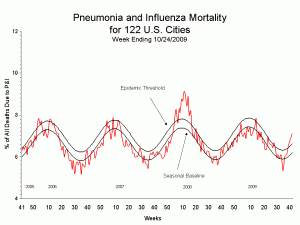 According to CDC data for the week ending 24 October, all but two states are reporting widespread influenza activity. Yet there are a handful news accounts and blogs that are raising the question whether H1N1 has peaked. Examples can be found at LA Times and the skepticist Wisdom Bits.
According to CDC data for the week ending 24 October, all but two states are reporting widespread influenza activity. Yet there are a handful news accounts and blogs that are raising the question whether H1N1 has peaked. Examples can be found at LA Times and the skepticist Wisdom Bits.
Anyone who has hazarded their savings to the financial markets is surely aware that it is difficult to find the top or bottom of a trend. With that in mind…
The percentage of deaths due to pneumonia and influenza has been above epidemic threshold for four consecutive weeks.
- There were an additional 22 deaths pediatric deaths in the U.S., (persons under age seventeen), bringing the total deaths in this group to 74 since 30 August and to 114 overall. Cumulative hospitalization rates for this group appear on a path that will markedly exceed the last three flu seasons.
- Outpatient visit rates for influenza-like illnesses (ILI) are sharply higher for this time of year. Eight percent of patient visits to doctor’s offices and clinics were from ILI, above the national baseline of 2.3%.
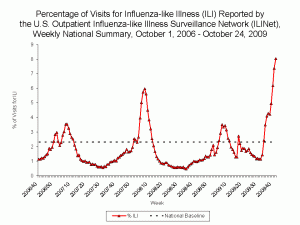
School closings are another barometer of the spread of H1N1.

AP: Swine flu prompts hundreds of schools to close
CIDRAP: Spikes in US indicators point to intensifying pandemic
Tagged: flu, h1n1, influenza, swine flu, US News
- Published:
- November 2, 2009 – 7:56 pm
- Author:
- By The Editor
- Categories:
-
- Comments:








 According to CDC data for the week ending 24 October,
According to CDC data for the week ending 24 October, 

